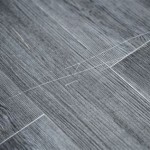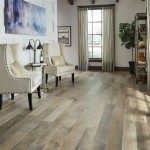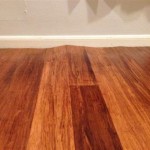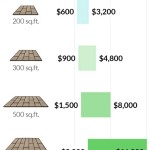Dark Hardwood Flooring Ideas: A Comprehensive Guide
Dark hardwood flooring has long been a coveted choice for homeowners seeking to imbue their spaces with a sense of sophistication, elegance, and timeless appeal. Its rich hues and luxurious feel can transform any room, creating a dramatic backdrop that complements a wide range of design styles. However, successfully incorporating dark hardwood flooring requires careful consideration of various factors, including room size, lighting conditions, and overall aesthetic goals. This article provides a comprehensive guide to exploring dark hardwood flooring ideas, offering insights and practical advice to help navigate the selection and implementation process.
The appeal of dark hardwood lies in its ability to create a sense of depth and drama. Unlike lighter woods, which tend to brighten and expand a space, dark hardwoods absorb light, lending an air of intimacy and coziness. This makes them particularly well-suited for larger rooms where a sense of warmth is desired. Furthermore, the contrast between dark flooring and lighter walls and furnishings creates a visually striking effect, highlighting architectural details and enhancing the overall design scheme. The choice of species, stain, and finish further contributes to the unique character of the flooring, offering a multitude of options to tailor the look to specific preferences.
Understanding the Nuances of Dark Hardwood Species
The selection of a specific wood species is a fundamental decision when opting for dark hardwood flooring. Different wood species possess unique characteristics in terms of grain pattern, hardness, and natural color variations. These attributes directly influence the final appearance and durability of the installed floor. Some popular choices for achieving a dark hardwood look include walnut, ebony, wenge, and dark-stained oak or maple. Each of these options presents a distinct aesthetic profile.
Walnut is renowned for its rich, chocolate-brown color and elegant grain patterns. It offers a luxurious and sophisticated appearance, making it a popular choice for formal living spaces and dining rooms. Ebony, on the other hand, is a naturally dark wood with a deep, almost black hue. It exudes a sense of drama and opulence, ideal for creating a striking visual statement. Wenge, an exotic hardwood from Africa, features a dark brown color with distinctive black grain lines. Its unique texture and color variation add a touch of exotic flair to any room. Oak and maple, while not naturally dark, can be stained to achieve a variety of dark shades. Dark-stained oak offers a classic and versatile look, while dark-stained maple provides a smoother and more uniform appearance.
Beyond aesthetics, the hardness of the wood is a crucial consideration for durability. The Janka hardness scale measures the resistance of wood to denting and wear. Species like wenge and Brazilian cherry are known for their superior hardness, making them ideal for high-traffic areas. Walnut and oak offer good durability, while softer woods like pine may be more prone to scratches and dents. The choice of species should therefore be based on a balance of aesthetic preferences and the anticipated level of foot traffic.
Optimizing Lighting and Room Size Considerations
Dark hardwood flooring absorbs light, so careful attention must be paid to lighting conditions and room size. In smaller rooms with limited natural light, dark flooring can create a cramped and gloomy atmosphere. Conversely, in large, well-lit spaces, dark flooring can add warmth and intimacy without feeling overwhelming. Strategic lighting design is therefore essential for maximizing the impact of dark hardwood.
In rooms with limited natural light, it is crucial to incorporate ample artificial lighting. Layering different types of lighting, such as ambient, task, and accent lighting, can help to brighten the space and highlight the beauty of the dark flooring. Recessed lighting, strategically placed lamps, and sconces can all contribute to a well-lit and inviting atmosphere. Choosing light-colored wall paints and furnishings can also help to reflect light and prevent the room from feeling too dark.
In larger rooms, dark hardwood can be used to create a sense of drama and sophistication. However, it is still important to ensure adequate lighting to avoid a cave-like effect. Consider using large windows or skylights to maximize natural light. Alternatively, incorporate statement lighting fixtures, such as chandeliers or pendant lights, to add visual interest and brighten the space. Using lighter area rugs can also help to break up the expanse of dark flooring and create a more balanced look.
Furthermore, the ceiling height plays a significant role in how dark flooring is perceived. In rooms with low ceilings, dark flooring can make the space feel even smaller and more confined. In such cases, it is advisable to choose lighter wall colors and opt for vertical design elements to draw the eye upwards. Conversely, in rooms with high ceilings, dark flooring can help to ground the space and create a more balanced and proportional feel.
Exploring Design Styles and Complementary Elements
Dark hardwood flooring is incredibly versatile and can complement a wide range of design styles, from traditional to modern and everything in between. The key to success lies in understanding how to balance the dark flooring with other design elements, such as wall colors, furniture, and accessories. The flooring serves as a foundation upon which the design vision is built.
For a traditional aesthetic, dark hardwood can be paired with rich, warm colors, such as golds, reds, and greens. Ornate furniture, antique rugs, and traditional artwork can further enhance the classic and elegant feel. Consider incorporating details like crown molding and wainscoting to add architectural interest and complement the flooring. A classic example is dark walnut flooring paired with Persian rugs and antique wooden furniture.
In a modern setting, dark hardwood can create a striking contrast with clean lines, minimalist furniture, and neutral color palettes. Light-colored walls, such as white or gray, will help to accentuate the dark flooring and create a sense of spaciousness. Incorporate metallic accents, such as stainless steel or chrome, to add a touch of contemporary flair. Consider using area rugs with geometric patterns or abstract designs to add visual interest. Ebony flooring combined with white furniture and stainless-steel accents creates a sophisticated and modern look.
For a rustic or farmhouse-inspired design, dark hardwood can be paired with natural textures, such as wood, stone, and linen. Warm, earthy colors, such as browns, creams, and greens, will complement the dark flooring and create a cozy and inviting atmosphere. Consider incorporating reclaimed wood furniture, vintage accessories, and handcrafted textiles to add character and charm. Dark-stained oak flooring with linen upholstery and reclaimed wood furniture reflects the rustic aesthetic.
The choice of wall color is particularly important when working with dark hardwood. Lighter wall colors, such as white, off-white, and light gray, will create a bright and airy feel, while darker wall colors, such as navy blue or charcoal gray, will create a more dramatic and moody atmosphere. Consider the overall aesthetic you are trying to achieve and choose wall colors that complement the dark flooring and enhance the desired mood.
Furniture selection should also be carefully considered. Lighter furniture pieces will create a contrast against the dark flooring, while darker furniture pieces will create a more cohesive and unified look. Consider the scale of the furniture in relation to the room size and the dark flooring. In smaller rooms, avoid using oversized furniture that can overwhelm the space. In larger rooms, larger furniture pieces can help to fill the space and create a more balanced and proportional feel.
Finally, rugs can be strategically used to add warmth, texture, and visual interest to a room with dark hardwood. Lighter rugs will create a contrast against the dark flooring, while darker rugs will create a more cohesive and unified look. Consider using area rugs to define different zones within a room, such as seating areas or dining areas. Choose rugs with patterns or textures that complement the overall design style of the room. A light-colored patterned rug on dark wenge flooring creates a focal point in a room.
Ultimately, the decision to incorporate dark hardwood flooring is a significant one that can transform any space. By carefully considering the factors outlined in this article, homeowners can confidently navigate the selection process and create a stunning and sophisticated interior that reflects their personal style and preferences.

Kitchen Dark Hardwood Floors Design Photos And Ideas Dwell

5 Tips To Pair Dark Floors With Light Walls Real Wood

3 Dark Floors Types And 26 Ideas To Pull Them Off Digsdigs

35 Gorgeous Ideas Of Dark Wood Floors That Look Amazing Floor Living Room Black Hardwood

29 Luxurious Dark Hardwood Floors For A Dramatic Statement

Designer Tips Dark Wood Flooring Ideas Factory Liquidators

Make Your Home Look Huge With Beautiful Dark Wood Flooring Betterdecorating

Living Room Dark Hardwood Floors Design Photos And Ideas Dwell

3 Dark Floors Types And 26 Ideas To Pull Them Off Digsdigs

What Furniture Goes With Dark Wood Floors Calgary
Related Posts








